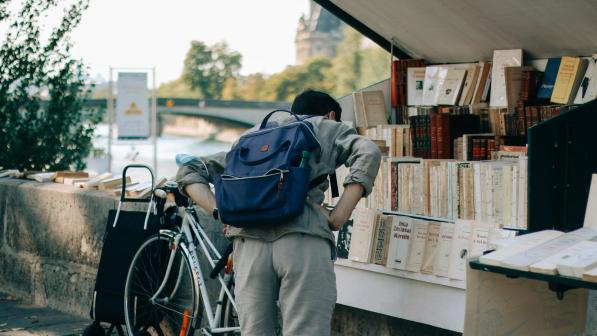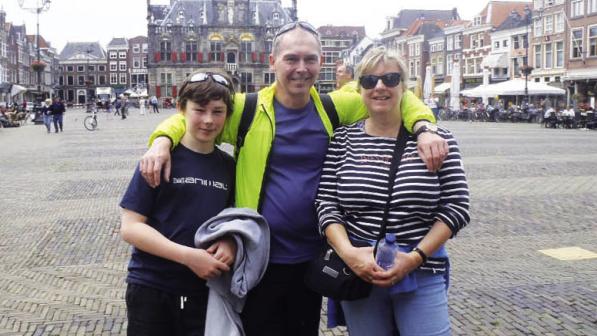Melissa & Chris Bruntlett: Curbing Traffic

Living the “Low-Car” City
It was only supposed to be five blog posts. But when our family first traveled from Vancouver to Rotterdam in the summer of 2016, we had no idea how quickly a simple writing assignment would spiral out of control. Those five online articles would form the basis for our book Building the Cycling City: The Dutch Blueprint for Urban Vitality, whose publication by Island Press in August 2018 transformed these two Canadians into inadvertent international ambassadors for the Netherlands.
Focused on the forward-thinking urban and transport planning policies that have transformed Dutch cities from places for cars to places for people, the book also provided concrete case studies of North American communities already translating these concepts onto their streets. Following a global speaking tour that saw us address 44 audiences in 25 cities across seven countries (including a once- in-a-lifetime trip across Australia and New Zealand), and countless media appearances—such as Vox, The Guardian, CityLab, National Public Radio, and the Canadian Broadcasting Corporation—we re- turned home to the Pacific Northwest with a life-changing decision to make. But to be honest, it was a fairly easy one.
After featuring Dutch Cycling Embassy (former) director Mirjam Borsboom in a chapter of Building the Cycling City, and then meeting Mobycon CEO Johan Diepens at our Ottawa book launch, the process of writing and promoting our first book became one gigantic job interview. And sure enough, in early 2019, the two of us were staring at employment offers from these respective organizations, both located in the small city of Delft: Melissa as international communications specialist for Mobycon, and Chris as marketing and communication manager for the Dutch Cycling Embassy. So, with very little hesitation, we reduced all of our earthly belongings into eight suitcases (and a cat carrier), pulled the children out of school midsemester, and traded the peaks of British Columbia for the lowlands of South Holland, eager to begin exporting the inspiring bicycle infrastructure and culture we’d been fervently touting for years.
Aside from it being the home of the eponymous Delfts blauw (Delft blue) pottery, the birthplace of Johannes Vermeer, and the assassination site of Willem van Oranje, (the main leader of the sixteenth-century Dutch Revolt against the Spanish Habsburgs), we knew precious little about our new hometown. We had not even set foot there until we arrived at the door of our rental apartment on a February morning in 2019. It was love at first sight, and within hours of wandering its quaint canals, cobbled streets, and historic squares, it became clear that we had—as one of our Twitter followers so eloquently put it—“met onze neus in de boter gevallen” (fallen with our nose in the butter).
This was an immense relief, as we had initially considered settling in some of the surrounding cities, but with both of our jobs located within a short cycle ride, it made sense to stay close to the kids as they transitioned into the public-school system. Coralie and Etienne, at the ages of 12 and 10 respectively, were understandably a bit more hesitant about this intercontinental move. But despite its being our warm and welcoming home for 11 wonderful years, all four of us were ready to “downsize” from big and bustling Vancouver, and Delft seemed to check all of our boxes: a compact and historic college town of just over 100,000 people—30,000 of whom study or work at the local university—where an incredible four-fifths of all journeys are made on foot, bicycle, or public transport (and no less than half of all trips are on a bicycle!).
In addition to the obvious (and ongoing) adjustment to a new language and culture, the starkest discovery was the myriad qualitative benefits that come with living in a place with far fewer motor vehicles. Even with high expectations, the first few weeks were nothing short of a revelation for our family; each day discovering the immense joys of living in a city that treated cars as guests, rather than guests of honor. Suddenly we found ourselves living in an environment where we could hear again.
Having been accustomed to the prevalence of engines, we had forgotten the sounds that give life to a city: people talking, birds singing, bells ringing, and music playing. At the same time, we watched our children enjoy the independence and freedom of moving autonomously on their own streets. These inclusive spaces welcomed virtually anyone; including the aging and disabled. In this immersive environment, levels of trust and compassion were clear through eye contact with fellow travelers. We saw how such an environment permits frequent and meaningful connections with our community, allowing us to meet and interact with our new neighbors.
Regardless of where we went, we crossed paths with Delft’s diverse demographic groups: the young and old, individuals across the economic spectrum, people of color, and those living with disabilities. In our eyes, virtually everyone was afforded the same respect and dignity of autonomously transporting themselves from A to B
Meilssa and Chris Bruntlett, authors of Curbing Traffic
Beyond the physical reaction to how it felt to move through Delft, we discovered new psychological and sociological benefits we hadn’t anticipated. The stress, frustration, and anxiety that had been an assumed part of our daily travels around Vancouver had all but disappeared. Feelings of isolation were soon replaced with a sense of belonging to this city, as we interacted with our fellow residents on its footpaths, streets, and cycle tracks. And improved social equity—at least in the public realm—was not a question but a reality. As we traveled through- out Delft, the divisions between age, gender, race, and class were far less distinguishable. Regardless of where we went, we crossed paths with Delft’s diverse demographic groups: the young and old, individuals across the economic spectrum, people of color, and those living with disabilities. In our eyes, virtually everyone was afforded the same respect and dignity of autonomously transporting themselves from A to B.
As we started sharing these observations on social media, we eventually came to the realization that, despite writing an entire book on the topic, “The Dutch Blueprint for Urban Vitality” isn’t really about bicycles. It’s about refusing to sacrifice vast amounts of the public realm to the private automobile; instead reserving space for commerce, community, and social connection. The ubiquitous bicycles are simply a by-product of that larger process; a tool to achieve the end goal of what policy makers call an autoluw (low-car or nearly car-free) city. At the same time, while we had been so focused on communicating the myriad benefits of cycling, it became clear that although not the stated intention of these transport policies, the improvements to social and emotional well-being resulting from decisions play—rather discreetly—a huge role in improving the livability of cities.
In going back through the archives and history of our adopted hometown, as well as “learning on the job” through our respective jobs, we were pleasantly surprised to learn that Delft was on the leading edge of that “traffic evaporation” trend that began five decades ago in the Netherlands. Around that time, a culture of innovation and exper imentation at Delft City Hall created a willingness to try new things (and sometimes even fail); ultimately changing the way cities across the country approach motor traffic circulation, residential street design, and bicycle network planning, and providing the inspiration for global cities to do the same.
Delft is a fairly small city, and would be easy to dismiss when discussing the challenges of larger regions like Los Angeles, London, or Melbourne. But its successes must be viewed in—and wouldn’t be possible without—the greater context of the Randstad (Rim City). A circular-shaped megalopolis, the Randstad is made up of 22 cit ies (including the Netherlands’ four largest: Amsterdam, Rotterdam, The Hague, and Utrecht), Europe’s largest port (Rotterdam) and third busiest airport (Schiphol), and 8.2 million residents. Delft’s proximity (around 10 kilometers, or 6 miles) to the centers of both Rotterdam and The Hague makes it ostensibly a suburb of each city, complete with convenient light/heavy rail and bicycle access. In that context, Delft is to the Randstad what Santa Monica is to Los Angeles, Tottenham is to London, or Yarra is to Melbourne. Or for that matter, what our former neighborhood of Grandview-Woodland is to the Greater Vancouver metropolitan area.
Vancouver is a city that will forever remain near and dear to our hearts, and one that has made tremendous strides in sustainable trans- port in the past decade, with two-thirds of all trips now made by foot, bicycle, or public transport. But like Delft, its successes must be viewed in the larger context of the Greater Vancouver metropolitan area. The city of Vancouver, for example, is just a single 115-square-kilometer (44-square-mile) municipality of 675,000 residents within a sprawl ing 2,877-square-kilometer (1,110-square-mile) region of 23 local au thorities and over 2.5 million people. The impressive statistics cited include only trips beginning and ending within city limits, and exclude the nearly three-quarters of regional journeys that take place in an automobile. Hundreds of thousands of cars pass in and out of the city each day.
These vehicles are not traveling on elevated highways (to its credit, Vancouver is the only major North American city without one), but on residential streets retrofitted into at-grade arterial roads that bisect its various communities, shifting the resulting externalities (air pollution, noise pollution, traffic collisions, reduced livability, etc.) from the outer suburbs onto the inner city. Furthermore, with practi cally all of the municipality’s energy focused on the downtown penin sula and affluent western neighborhoods, many other areas, arguably the ones most in need of investments in safer streets—due to higher active travel use and lower incomes—were regularly left out in the cold.
We were able to better quantify and comprehend our dramatic increase in quality of life several months after landing in Delft, and access ing the City of Vancouver’s traffic counts for our former neighborhood of Grandview-Woodland. We were shocked to learn that a staggering 150,000 cars moved within 100 meters (328 feet) of our East Vancouver apartment each day, with the vast majority exceeding the posted speed limit of 50 km/h (30 mph). In comparison, in our current home in Hof van Delft, just outside the city center, barely 1,500 cars pass within 100 meters each day; the vast majority no faster than 30 km/h (20 mph). Having far fewer cars in our lives brought obvious and not-so-obvious benefits to each member of our family, from lower exposure to air and noise pollution, to reduction of chronic stress, an increase in physical activity, and feelings of social connectivity.
“First we shape our cities, and then they shape us,” wrote Jan Gehl in 2010, paraphrasing Sir Winston Churchill, who at the time, was referring to the unique ability of the architect to influence and improve society. Gehl’s update reflects a mounting realization among planners, politicians, and policy makers that it’s not so much our buildings that shape us, as Churchill had insisted, but the space between them. This space has the potential to increase the autonomy and freedom of chil dren; improve sociability and trust between citizens; create more gen- der, age, and ability-equitable spaces; improve access to opportunity to all citizens; and ultimately create a city more resilient to the stresses of the present and future.
In most Western countries, since the Second World War, this public space has been monopolized and dominated by the private automobile. Recent years have seen an unprecedented push for a more equitable reallocation of this (curb and street) space—especially for walking and cycling—in metropolitan areas across the globe. Fueled by converging climate, health, and safety crises, there is a growing urgency to reduce the speed, access, and volume of cars, in residential and commercial areas alike. The COVID-19 pandemic has further fueled this challenge to the hegemony of cars in cities, as physical distancing requirements suddenly forced citizens to question this inefficient allowance of space. But by focusing on facts, figures, and charts, these discussions often miss the most critical element: the human one.
In the following chapters, the story of our first two years in Delft provides the backdrop for how this city, and many others like it in the Netherlands, ultimately succeeded in creating more human spaces. Looking beyond transport planning, policy, and design, we examine the growing body of research into the social and psychological impacts of automobile domination, including what happens when we start to reduce their prevalence, both from our streets and from our lives. The city we now call home does not exist in a bubble, and in reality, reflects many others across the globe. If Building the Cycling City offers the blueprint for how to create urban vitality, Curbing Traffic provides the reasons why cities and towns designed for people are so important for our individual and societal health and well-being.
In attempting to describe our new lives in Delft to the outside world, we find ourselves regularly returning to an analogy authored by Edinburgh-based blogger Robert Weetman in a 2017 post. He theorizes the experience of visiting the Netherlands for the first time through the eyes of someone who has spent their entire life standing in a cloud of flies. Life is possible, but the flies are omnipresent. The person can breathe, but they have to wear a mask. They can see, but they have to brush flies out their eyes to do so. They can hear, but they have to strain to listen. They can stay fairly healthy, but the flies make it harder to do so. Now imagine stepping into a world where those flies have mostly disappeared. Weetman’s apt analogy is no longer hypothetical for our family; it is our day-to-day reality. We navigate Delft’s streets with our senses engaged, seemingly for the first time. And it is something we believe the entire world deserves to experience firsthand.
From Curbing Traffic by Melissa Bruntlett and Chris Bruntlett. Copyright © 2021 Melissa Bruntlett and Chris Bruntlett. Reproduced by permission of Island Press, Washington, D.C.




